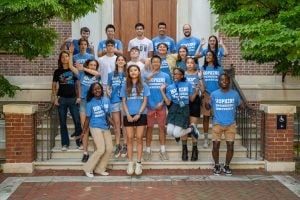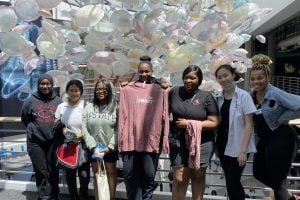
Clementina Okitikpi spent a recent summer morning with a pencil, a calculator, and a challenging chemistry problem: Figure out how many molecules of ammonia are in 10 kg of that substance. She was smiling, even as she wrinkled her forehead and bit her lip in concentration.
“It’s a challenge, and I like to be challenged,” said the 16-year-old from Lagos, Nigeria. “I want to learn all I can, so I can become a civil or environmental engineer someday.”
Okitikpi is one of more than 400 students taking part this summer in Engineering Innovation, the Whiting School’s intense, immersive precollege program that introduces engineering concepts and fields to bright, motivated high school students across the country. This summer, the program is being held at 12 sites, from California and Ohio to Pennsylvania and Maryland. Okitikpi is part of the cohort taking the course at SciTech High School in Harrisburg, PA.
“This is the first time I have had the opportunity to be part of something like this, and I really like it,” said the teenager, who just graduated from a Philadelphia high school in June, and will be attending Penn State University as an engineering major in the fall. “I have only been in the United States since last year, and they didn’t have a program like this in Nigeria.”
For Okitikpi, the EI program offers the opportunity to conquer basic  engineering concepts and brush up on skills before entering PSU’s classrooms in late August.
engineering concepts and brush up on skills before entering PSU’s classrooms in late August.
For Hoang Le, one of her classmates, EI means not only a chance to prepare for the rigors of a college engineering program, but also the opportunity to be surrounded by others his age who care deeply about learning and achieving.
“Since middle school, I have heard of friends who took EI, had amazing experiences, and went on to really rigorous colleges in engineering, because the program helped set them up with a good foundation,” said the 17-year-old, a rising junior at SciTech who came to the United States from Vietnam with his family when he was six years old. “I like being surrounded by other people who feel like I do about learning.”
Le particularly likes that EI involves not traditional classroom work involving pencil, paper, and calculators, but also practical, hands-on applications of that knowledge, such as Engineering Innovation’s Spaghetti Bridge competition. In the much-anticipated end-of-program contest, teams of students compete to design and construct the strongest-possible bridges using only dry pasta and epoxy. Kilo by kilo, weight is added to the structures until they shatter. Prizes are awarded to the teams whose bridges hold the most weight.
 “I really like that in this course, we get to apply what we learn to real problems, like building those bridges. It’s a challenge, and it’s fun,” said Le.
“I really like that in this course, we get to apply what we learn to real problems, like building those bridges. It’s a challenge, and it’s fun,” said Le.
Classmate Peng Lu feels much the same way. The 16-year-old rising junior describes himself as “one of those people who, when I was really little, would take things apart to figure out how they were made.”
An aspiring aeronautical engineer, Lu knows that in order to gain admission to engineering programs at schools like MIT, CalTech, Carnegie Mellon, and Johns Hopkins, he needs to set himself apart from his peers. He believes that what he is learning in Engineering Innovation this summer will help.
“The course is a good introduction to engineering,” said Lu, who came to the United States from China’s Sichuan province with his family when he was four years old. “But it’s also great that the program brings together kids from different schools, and that what we all have in common is our interest in engineering.”
Lu likes the course so much, in fact, that he brushes aside questions about whether he minds spending three hours a day – at least – outside class studying and preparing for the next day.
“Hey, I’m OK with that,” he said. “I am a goal-oriented person and I like to be challenged. I don’t want to just spend the summer sitting around. My opinion is that this is preparation for college, and that’s important.”
Kim Ketelsleger, EI Harrisburg teacher, calls this year’s group of students “phenomenal.”
“I have enjoyed teaching them challenging concepts ranging from circuit logic to structural design and watching them grasp the material. I was very impressed with how quickly the group became a team helping and learning from one another. The students improved their understanding of real world engineering applications and became more confident in problem solving,” she said.


